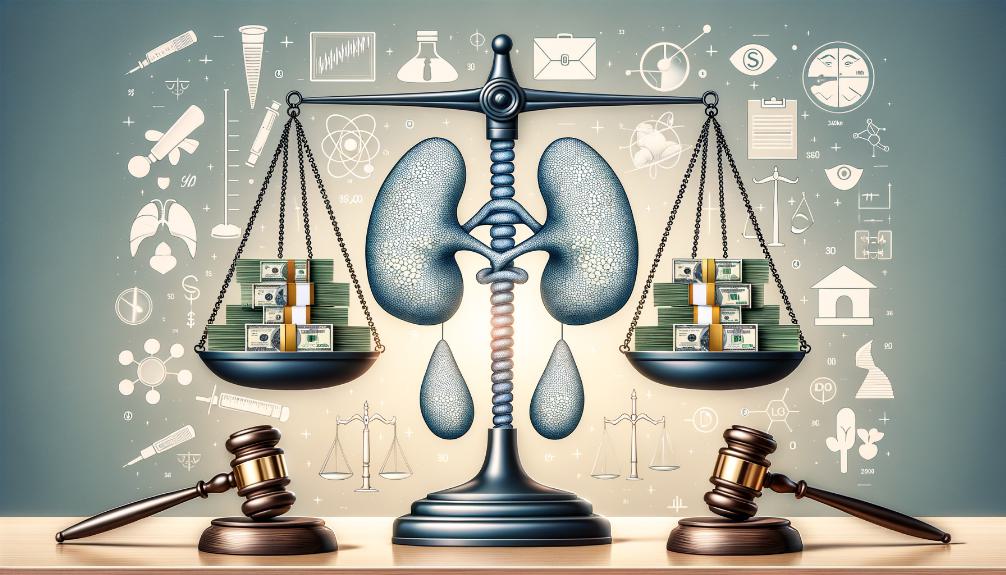Understanding Thyroid Disease Settlements From AFFF Exposure Claims
The intersection between Aqueous Film Forming Foam (AFFF) exposure and the emergence of thyroid diseases highlights a critical area of legal and medical scrutiny. As evidence mounts on the role of Per- and Polyfluoroalkyl Substances (PFAS) in disrupting thyroid hormone activity, individuals, particularly those with a history of extensive AFFF use, find themselves navigating a complex landscape of potential compensation claims. This discourse aims to unravel the intricacies of securing settlements for thyroid disease attributed to AFFF exposure, laying bare the legal, scientific, and medical frameworks that underpin these claims. The evolving nature of this issue beckons a closer examination of its facets, inviting a comprehensive understanding of the path forward for affected parties.

Key Takeaways
- AFFF exposure has been linked to an increased risk of various thyroid diseases due to PFAS contamination.
- Legal claims require detailed documentation of exposure and expert evidence linking it to thyroid dysfunction.
- Settlement amounts for thyroid disease from AFFF exposure are expected to range between $300,000 and $450,000.
- Specialized legal representation is essential for navigating the complex settlement process for AFFF-related thyroid disease claims.
AFFF and Thyroid Disease Link

Emerging research has established a concerning connection between exposure to Aqueous Film Forming Foam (AFFF) and an elevated risk of thyroid disease, attributed primarily to the presence of per- and polyfluoroalkyl substances (PFAS). These chemicals, integral to the firefighting foam's effectiveness in extinguishing oil and gasoline fires, have been linked to substantial health risks. Notably, PFAS disrupts the thyroid hormone system, which plays a critical role in metabolism, fertility, cardiovascular health, and fetal neurodevelopment. This disruption can lead to thyroid diseases such as hypothyroidism, hypothyroidism, Graves' disease, and Hashimoto's disease.
Studies focusing on firefighters regularly exposed to AFFF during firefighting and training exercises have shown a disturbing trend. This demographic is at a higher risk of developing thyroid diseases due to PFAS contamination, highlighting the occupational hazards they face. The health implications of such exposure extend beyond the firefighters themselves, potentially affecting pregnancy outcomes and fetal development due to the thyroid's critical role in these processes.
Given the severity of these health risks, individuals diagnosed with thyroid diseases linked to AFFF exposure are increasingly seeking compensation. This move is a response to the growing body of evidence that ties PFAS contamination to thyroid health issues. As awareness of the risks associated with AFFF and PFAS grows, so does the urgency for affected individuals to seek redress for the harm they have suffered.
Legal Pathways for Claimants

Navigating the legal pathways for AFFF exposure claims requires claimants to meticulously compile evidence of their exposure and its link to thyroid disease. This involves a detailed gathering of medical records, employment history, and military service documents that substantiate the claimant's contact with AFFF and subsequent diagnosis of thyroid disease. The complexity of demonstrating a causal link between AFFF exposure and thyroid disease necessitates a comprehensive approach, incorporating expert medical opinions alongside scientific evidence to build a compelling case.
The legal pathways for these claimants are not straightforward, requiring a deep understanding of the intersection between environmental law, personal injury, and medical science. Legal assistance becomes invaluable in this context, guiding claimants through the labyrinthine process of filing claims. Lawyers specializing in AFFF exposure cases can ensure that every piece of necessary documentation is correctly prepared and submitted, from employment records that verify AFFF exposure to medical records confirming a thyroid disease diagnosis.
To achieve settlements that adequately compensate for the myriad damages incurred—covering medical expenses, lost wages, pain, and suffering, among others—claimants must present a well-documented case that leaves no doubt about the causal link between AFFF exposure and their thyroid condition. The goal of these settlements is not only to provide financial relief but also to acknowledge the impact that AFFF exposure has had on the claimants' health and well-being. Thus, navigating the legal pathways for AFFF exposure claims is a critical step in securing just compensation for those affected by thyroid disease as a result of their exposure.
Scientific Evidence Overview

A growing body of scientific evidence establishes a clear link between exposure to PFAS chemicals in AFFF and the disruption of thyroid hormone functions, leading to various thyroid diseases. These findings emphasize the detrimental impact that PFAS exposure through AFFF can have on thyroid health, spotlighting the chemicals' role as potent endocrine disruptors. Research indicates that PFAS chemicals, when accumulated in thyroid cells, can greatly inhibit the activity of essential enzymes such as thyroperoxidase. This enzyme is necessary for the synthesis of thyroid hormones, and its inhibition can lead to an imbalance in hormone levels, manifesting as thyroid dysfunction.
Further studies elucidate that PFAS exposure is associated with an increased risk of developing thyroid diseases, including hypothyroidism and Graves' disease. The mechanism behind this association lies in the ability of PFAS to disrupt the delicate balance of thyroid hormone synthesis. By acting as endocrine disruptors, PFAS can lead to abnormal levels of thyroid hormones, a condition that is pivotal in the development of thyroid disorders.
Recent research has highlighted a strong association between PFAS exposure, particularly from AFFF, and the onset of thyroid dysfunction. This connection is particularly concerning given the widespread use of AFFF in various industrial and firefighting applications. The specific categories of PFAS present in AFFF have been shown to have varying effects on thyroid function, further complicating the relationship between PFAS exposure and thyroid health. These findings collectively underscore the pressing need for awareness and action regarding the impact of PFAS on thyroid health among individuals exposed to AFFF.
Compensation Expectations

Given the significant health implications highlighted by the scientific evidence on PFAS exposure and thyroid dysfunction, attention now turns to the financial ramifications for affected individuals through thyroid disease settlements from AFFF exposure claims. The intersection of medical research and legal action has illuminated a path for compensation, underlining the crucial role of understanding the nuances of AFFF exposure claims.
Thyroid disease settlements offer a beacon of hope for those affected, with compensation amounts potentially ranging from $300,000 to $450,000. These figures are not arbitrary; they reflect the severity of thyroid dysfunction, the specific type of cancer diagnosed, the individual's exposure history to PFAS chemicals, and their age. Such compensation aims to address the profound impact these hazardous substances have on thyroid function, offering some measure of redress for the victims.
As we move forward, eligible individuals can anticipate settlement negotiations to commence in 2024. This timeline underscores the importance of preparing claims with detailed documentation of exposure history and the resultant health issues. Legal assistance becomes indispensable in this context, guiding claimants through the complex landscape of settlement negotiations. Lawyers specializing in AFFF exposure claims can provide the expertise needed to navigate the process effectively, ensuring that the compensation reflects the extent of harm suffered.
Selecting Legal Representation

Choosing the right legal representation is a critical step for individuals seeking thyroid disease settlements from AFFF exposure claims. The intricate nature of these cases, encompassing the evaluation of medical records, employment history, and exposure details, necessitates the expertise of skilled attorneys well-versed in the complexities of environmental litigation. These professionals play an indispensable role in navigating the multifaceted legal landscape, ensuring that all relevant documentation is meticulously prepared and submitted, thereby strengthening the foundation of compensation cases.
Skilled attorneys specializing in AFFF-related cases are instrumental in assessing eligibility for compensation, guiding clients through the filing claims process, and providing invaluable advice on the legal avenues available. Their proficiency in handling similar lawsuits enables them to anticipate potential challenges and devise effective strategies to overcome them, greatly enhancing the likelihood of securing a favorable outcome. Moreover, their experience in settling AFFF-related cases equips them with the unique insights required to negotiate the best possible terms for their clients.
The importance of selecting the right legal representation cannot be overstated. The quality and expertise of the legal team representing an individual in thyroid disease settlements from AFFF exposure claims can markedly influence the settlement amount and overall success of the case. Consequently, individuals impacted by AFFF exposure should diligently research and choose attorneys who have a proven track record in complex litigation processes, particularly those involving environmental contaminants. This careful selection ensures that claimants are well-supported throughout the legal journey, maximizing their chances of receiving the compensation they deserve.
Frequently Asked Questions
What Is the Average Payout for the AFFF Lawsuit?
The average payout for AFFF lawsuits typically falls within the range of $300,000 to $450,000. This amount is influenced by various factors, including the type of cancer, exposure history, and the plaintiff's age.
Can AFFF Cause Thyroid Problems?
Aqueous Film Forming Foam (AFFF) contains per- and polyfluoroalkyl substances (PFAS) that have been linked to thyroid problems, including hypothyroidism, hyperthyroidism, Graves' disease, and Hashimoto's disease, by disrupting thyroid hormone systems and inhibiting enzyme activity.
Is There a Settlement for AFFF in 2023?
Yes, in 2023, a significant $10.3 billion global settlement agreement was reached to address water contamination claims linked to AFFF, including compensation for individuals suffering from thyroid disease and other conditions due to PFAS exposure.
Who Qualifies for the AFFF Lawsuit?
Individuals diagnosed with thyroid diseases and with documented exposure to AFFF, particularly military and civilian firefighters, may qualify for the AFFF lawsuit against manufacturers like 3M and DuPont for health impacts linked to PFAS chemicals.
Conclusion
The link between Aqueous Film Forming Foam (AFFF) exposure and the development of thyroid diseases exemplifies a critical area of concern, necessitating legal intervention for affected individuals. The synthesis of legal frameworks with emerging scientific evidence underscores the potential for claimants to seek and obtain compensation. As such, selecting adept legal representation becomes paramount in navigating these complex claims. This intersection of environmental health science and law paves the way for addressing and remedying the impacts of PFAS exposure on thyroid health.


![Firefighting Foam Lawsuit [2024]: Were You Or A Loved One Diagnosed With Cancer 19 foam lawsuit cancer diagnosis](https://lawsuitlegit.com/wp-content/uploads/2024/02/foam_lawsuit_cancer_diagnosis-250x143.jpg)

